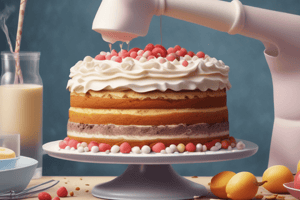Podcast
Questions and Answers
Match the following mixing methods with their description:
Match the following mixing methods with their description:
Straight dough = All ingredients combined and mixed until dough is smooth and well developed Creaming or conventional = Shortening and sugar creamed; eggs added, then liquids (if any) added alternately with sifted dry ingredients at low speed Liquid shortening = All ingredients blended on low speed, then whipped on high, and finally medium speed, to aerate Angel food = Egg whites and sugar whipped until soft peaks form; sifted dry ingredients gently folded in
Match the following mixing methods with their examples of use:
Match the following mixing methods with their examples of use:
Straight dough = Yeast-raised breads Creaming or conventional = Shortened cakes and coffee cakes, cookies, cake-like muffins Muffin or one-stage = Muffins, quick breads, quick coffee cakes Angel food = Angel food cake
Match the following mixing methods with their description:
Match the following mixing methods with their description:
Sponge and dough = Liquid, yeast, part of flour, part of sugar mixed into batter or dough (called a sponge or preferment) and allowed to ferment; added to remaining ingredients and mixed until dough is smooth and well developed Two-stage or blending = Sifted dry ingredients blended on high speed; softened fat cut in with paddle; liquids added slowly to blend in two stages (eggs added in second stage), then beaten to aerate Sponge or whipping = Warmed whole eggs (or yolks) and sugar whipped until very light and thick; liquids added, sifted dry ingredients gently folded in, followed by melted butter (if required) or whipped whites (if separated) Chiffon = Sifted dry ingredients stirred or blended on low speed; oil and other liquid ingredients added and lightly blended until smooth; egg whites and sugar whipped until soft peaks form and folded into flour-oil mixture
Match the following mixing methods with their examples of use:
Match the following mixing methods with their examples of use:
Match the following mixing methods with their description:
Match the following mixing methods with their description:
Match the following mixing methods with their examples of use:
Match the following mixing methods with their examples of use:
Match the following mixing methods with their description:
Match the following mixing methods with their description:
Match the following mixing methods with their examples of use:
Match the following mixing methods with their examples of use:
Flashcards are hidden until you start studying
Study Notes
Mixing Methods for Baked Goods
- Straight Dough: All ingredients combined and mixed until dough is smooth and well developed, used for yeast-raised breads.
Creaming or Conventional Method
- Shortening and sugar creamed, eggs added, then liquids (if any) added alternately with sifted dry ingredients at low speed, used for shortened cakes and coffee cakes, cookies, and cake-like muffins.
Liquid Shortening Method
- All ingredients blended on low speed, then whipped on high, and finally medium speed to aerate, used for high-ratio liquid shortening cakes.
Angel Food Method
- Egg whites and sugar whipped until soft peaks form, sifted dry ingredients gently folded in, used for angel food cake.
Muffin or One-Stage Method
- Sifted dry ingredients stirred or blended on low speed, liquid fat and other liquid ingredients added in one stage and lightly blended just until moistened, used for muffins, quick breads, and quick coffee cakes.
Sponge and Dough Method
- Liquid, yeast, part of flour, and part of sugar mixed into batter or dough (called a sponge or preferment) and allowed to ferment, then added to remaining ingredients and mixed until dough is smooth and well developed, used for yeast-raised breads made with poolish, biga, levain, or other sponge or preferment.
Two-Stage or Blending Method
- Sifted dry ingredients blended on low speed, softened fat cut in with paddle, liquids added slowly to blend in two stages (eggs added in second stage), then beaten to aerate, used for high-ratio cakes.
Sponge or Whipping Method
- Warmed whole eggs (or yolks) and sugar whipped until very light and thick, liquids added, sifted dry ingredients gently folded in, followed by melted butter (if required) or whipped whites (if separated), used for sponge cake, genoise, ladyfingers, and madeleines.
Chiffon Method
- Sifted dry ingredients stirred or blended on low speed, oil and other liquid ingredients added and lightly blended until smooth, egg whites and sugar whipped until soft peaks form and folded into flour-oil mixture, used for chiffon cake.
Biscuit or Pastry Method
- Sifted dry ingredients stirred or blended on low speed, solid fat rubbed or cut in by hand or with paddle, liquids stirred in gently, used for biscuits, scones, pie pastry, and blitz puff pastry.
Studying That Suits You
Use AI to generate personalized quizzes and flashcards to suit your learning preferences.



